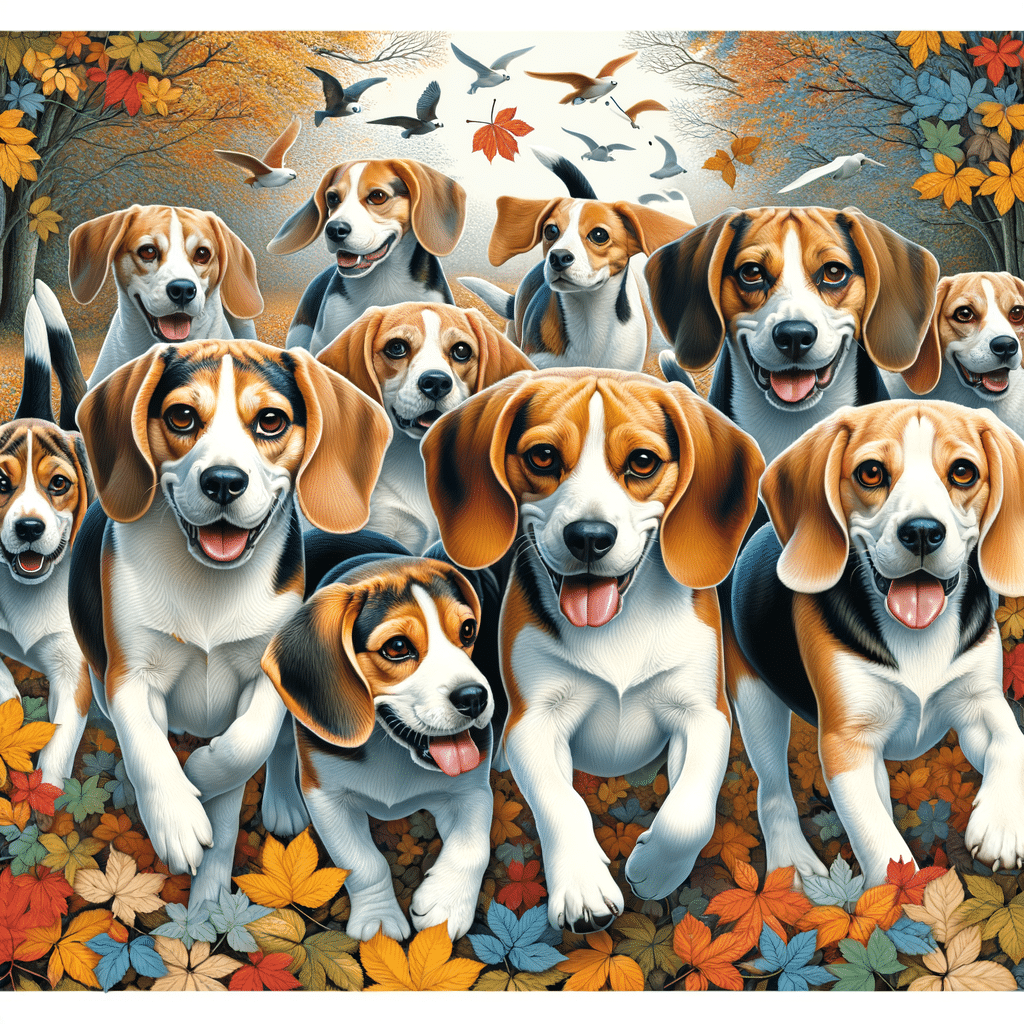With its compact size and affable personality, the beagle has been a popular dog breed for generations. Among the diverse coat patterns beagles are known for, the spotted white beagle has an appearance that sets it apart from other varieties. While not a breed standard, spotted white beagles capture attention with unique markings, including spots or larger patches of color against a predominantly white background.
In This Article
These spotted beagles share the same friendly temperament and keen sense of smell as their counterparts, making them just as suited for companionship and activities that rely on their acute olfactory abilities. For prospective beagle owners, understanding the characteristics that define the spotted white variant is crucial for proper care and to appreciate the full extent of their personalities. This allows owners to cater to the needs of their spotted companions effectively, ensuring a happy and healthy life.
Highlights
- Beagles come in various coat patterns, including the less common spotted white.
- Spotted white beagles possess the same endearing qualities and abilities as other beagles.
- Recognition and proper care are key to maintaining the well-being of a spotted white beagle.
Exploring the Beagle Breed
The beagle breed, renowned for its friendly demeanor and distinctive look, is a popular choice among dog lovers for both companionship and working roles. Understanding its historical background and breed standards is essential for appreciation and recognition.
Breed History and Origin
Beagles were originally bred in England, where they were bred to hunt small game due to their exceptional sense of smell. The American Kennel Club (AKC) recognized beagles as a breed in 1885 and registered with the United Kennel Club (UKC). These organizations maintain breed standards that are critical for maintaining the integrity of the breed lineage.
Breed Appearance and Standards
The breed standard for beagles, as outlined by the AKC and UKC, includes specifics regarding their appearance:
- Size: beagles commonly come in two size varieties: those under 13 inches at the shoulder and those between 13 to 15 inches.
- Coat: A beagle's coat should be medium length, lie flat against the skin, and slightly rough. The classic tricolor pattern includes black, white, and brown, but beagles can also sport spots, freckles, and larger patches.
- Color Markings: A purebred beagle's coat can display distinct spots. Tri-color is the most common, where the spots particularly stand out on the white areas of the fur.
- Physical Traits: A signature trait of this dog breed is a white-tipped tail. Other common markers of the breed are white paws and large, droopy ears.
You can look for a few signs of dog health. The beagle should exhibit proper proportions and solid bone structure. These dogs are celebrated as family pets for their loving nature; breed standards ensure the beagle remains a well-recognized and purebred companion.
The Spotted White Beagle
The spotted white beagle is prized for its unique markings and a broad spectrum of color patterns that separate it from the standard tri-color or bi-color beagles. This section explores what sets the spotted white beagle apart regarding its coat.
Unique Coat Colors
Spotted white beagles may exhibit non-standard color combinations, less common but highly regarded among enthusiasts. These unique coat colors include variations like lemon, red, or blue tick marks on a white base.
Patterns and markings may consist of:
- Ticking: Small spots resembling freckles, usually found within the white areas of the coat.
- Large spots: Irregular patches of color contrasting starkly against the white background.
It should be noted that while spotting is accepted within the breed standard, the presence of spots alone does not determine a beagle’s purity or lineage. Whether adorned with standard tri-coloration or showcasing a less common bi-color pattern with ticking, the spotted white beagle remains a beloved and sought-after version of this versatile breed.
Color Patterns and Markings
Beagle coat colors and patterns in spotted white beagles vary, with white often being the base color. The breed may display different types of patches or spots, ranging from subtle ticking to more pronounced spotting.
The following list outlines the primary coat color patterns found in spotted white beagles:
- Tri-color Beagle: Black, white, and brown, with spotted variations.
- Bi-color Beagle: Typically combinations like black and white, brown and white, or tan and white, sometimes with spots.
- Rare Colors: Lemon and white, red and white, blue tick, or tan and redtick, where white areas can be visibly spotted.
Caring for Your Beagle
A dog owner with a beagle, particularly a spotted white beagle, must understand dog health and how to promote it. Their health and wellness, dog training and socialization, and exercise and grooming routines will ensure a happy and healthy life.
Health and Wellness
A beagle’s health should always be at the forefront of care. They need regular check-ups with a veterinarian to protect against common health issues like obesity, ear infections, and hypothyroidism. The right balance of diet and exercise is crucial.
- Diet: High-quality dog food suitable for their age, size, and activity level
- Vaccinations: Up-to-date to prevent common diseases
Training and Socialization
Early socialization is essential for beagles due to their hunting dog heritage. Basic obedience training can harness their snoopy nature and strong sense of smell, and introducing a beagle to various environments and people helps them become well-rounded and friendly companions.
Exercise and Grooming Requirements
Beagles are energetic and require ample exercise to maintain their health. Additionally, despite short coats, regular grooming is required to keep shedding manageable and their coat healthy.
- Exercise: 2-3 daily walks of at least 20 minutes and interactive play like fetch
- Grooming: Weekly brushing, regular ear cleaning, and nail trimming as needed
Providing this care helps nurture the beagle’s inherent temperament‚ loyal, friendly, and social‚ making them excellent companions, service dogs, and participants in dog sports. A suitable care routine ensures beagles can be more than pets; they’re loyal companions who are part of the family for any dog owner.
Frequently Asked Questions
In this section, readers will find precise answers to common inquiries regarding the different types of characteristics, pricing, rarity, care, and breed verification of beagles with a pattern of white and black spots.
What are the distinct characteristics of a beagle with white and black spots?
A white and black spotted beagle typically displays a coat with a mix of white and black patches. These spots vary in size and pattern, with some dogs having large patches while others exhibit more minor, freckle-like markings.
How does one identify reputable breeders for white-spotted beagle puppies?
To identify reputable breeders of white-spotted beagle puppies, prospective owners should look for breeders who provide thorough health clearances, are transparent about their breeding practices, and have a good reputation with previous customers.
What is the typical price range for a white spotted beagle?
The price for a white spotted beagle varies significantly depending on factors such as pedigree, breeder reputation, and geographic location. Prices can range from $400 to over $1000.
How rare are beagles with a predominantly white coat?
Beagles with a predominantly white coat are uncommon compared to the traditional tri-color variety. While rare, they are recognized within the breed standard and may be born in some litters.
What care considerations should be considered for a beagle with a white and spotted coat?
Regular grooming is necessary for white and spotted beagles to maintain a healthy coat. Additionally, they should be monitored for skin issues, as white coats may be more sensitive to sunlight and other environmental factors.






